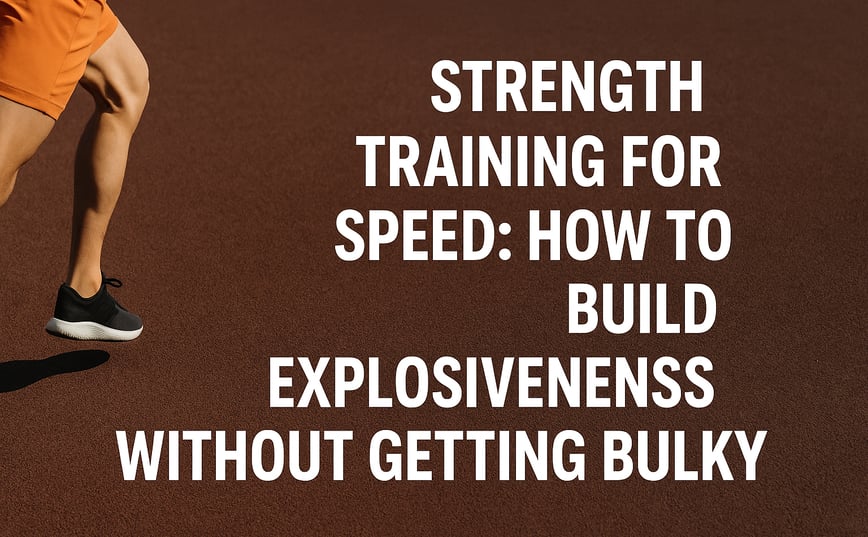Build Explosive Speed Without Bulking Up: The Strength Strategy Elite Athletes Use
Want to get faster without gaining unnecessary size? Discover the science-backed strength training methods that build explosive speed through plyometrics, force development, and optimal strength-to-weight ratio. Perfect for track, soccer, basketball, and speed-focused athletes.
5/22/20253 min read


Strength Training for Speed: How to Build Explosiveness Without Getting Bulky
Why Strength Matters for Speed—But Size Doesn’t
If you're an athlete in a speed-focused sport—like track, soccer, basketball, or even football skill positions—you need to build strength without sacrificing quickness. The goal isn’t to get bigger. It’s to get stronger, more explosive, and more reactive while keeping your body weight optimized for performance.
So how do you do that? You focus on force development, explosive power, and your strength-to-weight ratio. Here's how to train smarter—not heavier.
1. Strength-to-Weight Ratio: Your Real Speed Multiplier
Your ability to generate force relative to your body weight is what makes you explosive. A stronger athlete who can apply more force per step—without carrying excess mass—accelerates faster and changes direction more efficiently.
For speed athletes, it's not about lifting the most—it’s about producing power quickly and efficiently. Think of it as lean strength.
2. Don’t Skip Max Strength
Contrary to popular belief, strength training won’t automatically make you bulky. Hypertrophy (muscle growth) happens with high volume, high reps, and long time-under-tension.
Instead, go for low reps (3–5), heavier weight (80–90% 1RM), and longer rest (2–3 minutes). Exercises like trap bar deadlifts, front squats, and weighted pull-ups are perfect for developing power without size.
Example Routine:
Trap Bar Deadlift – 4x4
Bulgarian Split Squat – 3x6 (each leg)
Weighted Pull-Ups – 3x5
Core Work (hollow holds, planks) – 2x30 sec
Product We Recommend: Pro – Neck Training System
Why it helps:
Neck and cervical spine strength improves force transfer, posture, and collision resilience—essential for athletes in contact or high-speed sports. It also helps reduce the risk of concussions. Amazon.
How to use it:
Use before lifting or sprint sessions. Perform controlled, multidirectional neck movements for 1–2 sets of 10 reps in each direction.
Best for:
Football players, sprinters, and anyone working on neck control and injury prevention.
3. Plyometrics: The Missing Link Between Strength & Speed
This is where raw strength becomes usable athletic power. Plyometrics teach your body to produce force quickly—and absorb it safely. You’re training your rate of force development, which is critical for sprinting, jumping, and agility.
Start with low-level plyos like:
Skater hops
Jump squats
Pogos (quick ankle hops)
Depth drops
Then build into higher-intensity drills:
Depth jumps
Single-leg bounds
Broad jumps
Tip: Keep reps low (3–6 per set), focus on explosive intent, and take long rest (1–2 min) to stay powerful.
4. Sprint Technique + Overspeed Work
Sprinting itself is strength work when done right. Emphasize high-output mechanics:
Forward shin angle at acceleration
Stiff ankle contact during max velocity
Upright posture with rapid turnover
Add overspeed drills like slight downhill sprints or resistance band-assisted strides 1–2 times per week. These train the nervous system to fire faster and increase top-end speed.
Product We Recommend: SKLZ Resistance Speed Cord
Why it helps:
This resistance band with a waist harness provides drag during sprints to increase stride power and drive mechanics. It’s a low-tech but high-impact way to train both acceleration and resisted sprinting mechanics. Amazon.
How to use:
Partner up or anchor it to a sled/pole. Sprint for 10–15 yards, focusing on knee drive and arm action. Great for both resistance and overspeed progressions.
Best for:
Track athletes, football players, soccer players, and basketball guards.
5. Balance It With Mobility & Tendon Health
Speed athletes often overlook recovery, but tight hips, stiff ankles, and weak tendons will slow you down and increase your injury risk.
Add 2–3 short mobility circuits per week focused on:
Hip flexor release
Ankle dorsiflexion
Glute activation
Core control (anti-rotation drills)
Product We Recommend: Roll Recovery R8 Plus
Why it helps:
This spring-loaded massage roller targets tight quads, IT bands, and hamstrings with deep compression. It’s designed specifically for runners and speed athletes to recover without spending hours foam rolling. Amazon.
How to use:
Roll out legs post-sprint or training session for 1–2 minutes per muscle group. Great for active recovery days.
Best for:
Sprinters, soccer players, and hoopers with tight hips or hamstrings.
Sample Weekly Template (for Speed/Power Athletes)
Day 1 – Strength + Sprint Acceleration
Trap bar deadlifts
Weighted push-ups
Sprint start mechanics
Day 2 – Plyometrics + Mobility
Depth drops
Lateral bounds
Hip/ankle mobility
Day 3 – Sprint Mechanics + Top Speed
Flying 10s
Resistance band sprints
Core + neck work
Day 4 – Strength + Contrast Training
Front squat + jump squats (contrast sets)
Pull-ups
Sprint mechanics review
Day 5 – Recovery + Regeneration
Mobility work
R8 rolling
Light aerobic movement
Final Thoughts: Power Without the Bulk
You don’t have to get huge to get fast. In fact, most speed athletes benefit from lean strength, powerful nervous system output, and mobility control—not raw size.
By focusing on:
Smart strength (low reps, high intensity)
Plyometric development
Sprint-specific drills
Recovery tools for mobility & tendon health
…you’ll build the kind of strength that actually makes you faster, not slower.
Whether you’re on the track, the field, or the court—strength-to-weight ratio and power output are what make explosive athletes stand out.
Train smart. Stay fast. Don’t bulk when you can blast.
FITNESS
Nutrition
WellnesS
info@movebetterco.com
© 2025. All rights reserved | Privacy Policy | Terms & Conditions